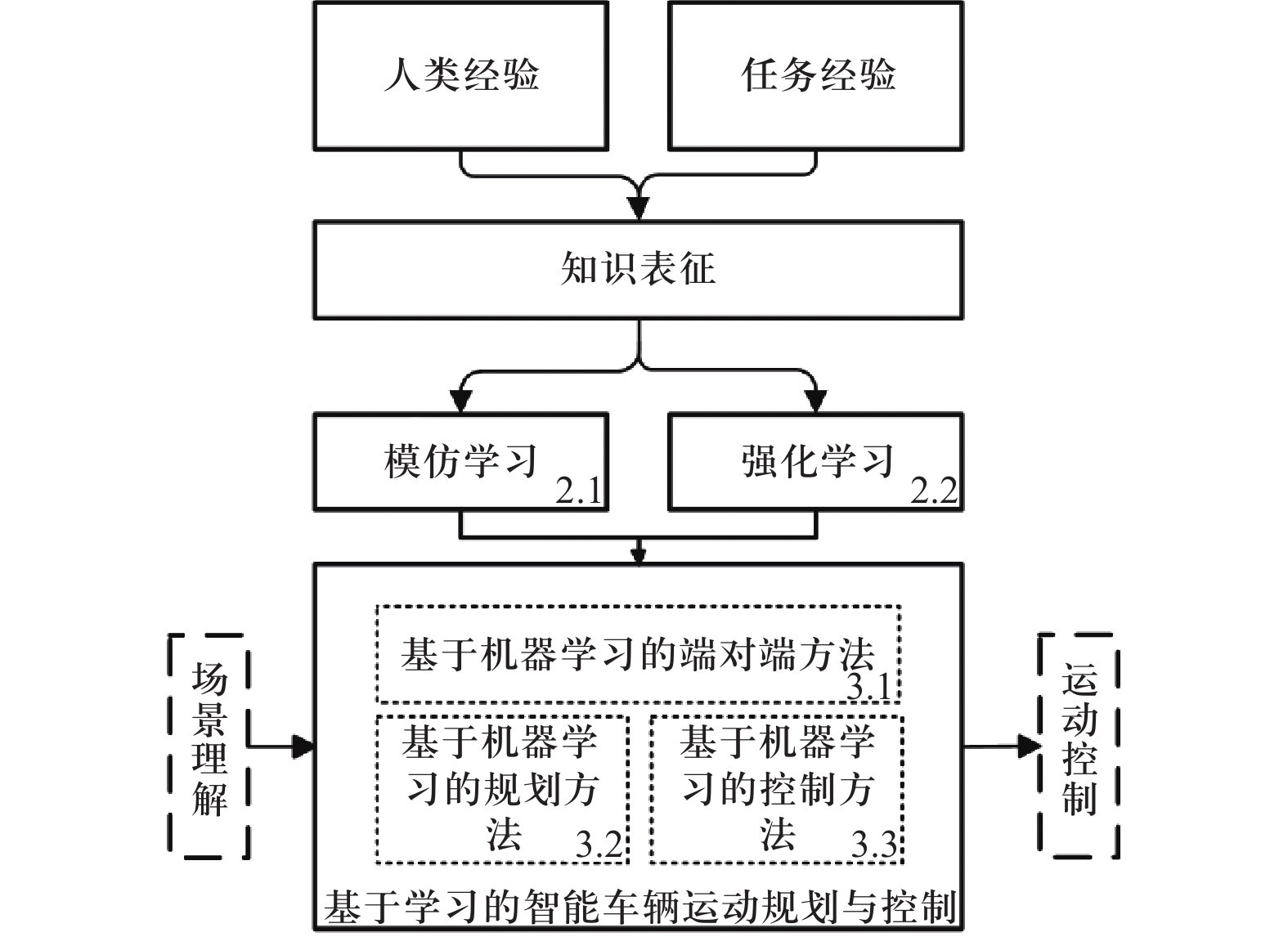| [1] |
NARANJO J E, GONZALEZ C, GARCIA R, et al. Lane-change fuzzy control in autonomous vehicles for the overtaking maneuver[J]. IEEE Transactions on Intelligent Transportation Systems, 2008, 9(3):438 − 450.doi:10.1109/TITS.2008.922880
|
| [2] |
KLANČAR G, ŠKRJANC I. Tracking-error model-based predictive control for mobile robots in real time[J]. Robotics and Autonomous Systems, 2007, 55(6):460 − 469.doi:10.1016/j.robot.2007.01.002
|
| [3] |
VERSCHUEREN R, ZANON M, QUIRYNEN R, et al. Time-optimal race car driving using an online exact hessian based nonlinear mpc algorithm[C]//Proceedings of 2016 European Control Conference (ECC), [S.l.]: ECC, 2016: 141 − 147.
|
| [4] |
VERSCHUEREN R, FERREAU H J, ZANARINI A, et al. A stabilizing nonlinear model predictive control scheme for time-optimal point-to-point motions[C]//Proceedings of 2017 IEEE 56th Annual Conference on Decision and Control (CDC), 12−15 Dec. [S.l.]: IEEE, 2017: 2525 − 2530.
|
| [5] |
刘凯, 龚建伟, 陈舒平, 等. 高速无人驾驶车辆最优运动规划与控制的动力学建模分析[J]. 机械工程学报, 2018, 54(14):141 − 151.LIU Kai, GONG Jianwei, CHEN Shuping, et al. Dynamics modeling analysis of optimal motion planning and control of high-speed unmanned vehicles[J]. Journal of Mechanical Engineering, 2018, 54(14):141 − 151. (in Chinese)
|
| [6] |
KAPANIA N R, GERDES J C. Design of a feedback-feedforward steering controller for accurate path tracking and stability at the limits of handling[J]. Vehicle System Dynamics, 2015, 53(12):1687 − 1704.doi:10.1080/00423114.2015.1055279
|
| [7] |
WURMAN P R, BARRETT S, KAWAMOTO K, et al. Outracing champion gran turismo drivers with deep reinforcement learning[J]. Nature, 2022, 602(7896):223 − 228.doi:10.1038/s41586-021-04357-7
|
| [8] |
CHEN J, YUAN B, TOMIZUKA M. Model-free deep reinforcement learning for urbanautonomous driving[C]//Proceedings of 2019 IEEE Intelligent Transportation Systems Conference. [S.l]: ITSC, 2019: 2765 − 2771.
|
| [9] |
PAN Y, CHENG C-A, SAIGOL K, et al. Imitation learning for agile autonomous driving[J]. The International Journal of Robotics Research, 2019, 39(2-3):286 − 302.
|
| [10] |
SAMSAMI M R, BAHARI M, SALEHKALEYBAR S, et al. Causal imitative model for autonomous driving [J]. arXiv preprint arXiv: 211203908, 2021.
|
| [11] |
BOJARSKI M, DEL TESTA D, DWORAKOWSKI D, et al. End to end learning for self-driving cars[J]. arXiv preprint arXiv: 160407316, 2016.
|
| [12] |
KRETZSCHMAR H, SPIES M, SPRUNK C, et al. Socially compliant mobile robot navigation via inverse reinforcement learning[J]. The International Journal of Robotics Research, 2016, 35(11):1289 − 1307.doi:10.1177/0278364915619772
|
| [13] |
MULLER U, BEN J, COSATTO E, et al. Off-road obstacle avoidance through end-to-end learning[J]. Proceedings of the 18th International Conference on Neural Information Processing Systems, [S.l.]:MIT Press,2005:5-8.
|
| [14] |
JI X, HE X, LV C, et al. Adaptive-neural-network-based robust lateral motion control for autonomous vehicle at driving limits[J]. Control Engineering Practice, 2018, 76:41 − 53.
|
| [15] |
LI Z, GONG J, LU C, et al. Interactive behavior prediction for heterogeneous traffic participants in the urban road: a graph-neural-network-based multitask learning framework[J]. IEEE/ASME Transactions on Mechatronics, 2021, 26(3):1339 − 1349.doi:10.1109/TMECH.2021.3073736
|
| [16] |
LU C, HU F, CAO D, et al. Transfer learning for driver model adaptation in lane-changing scenarios using manifold alignment[J]. IEEE Transactions on Intelligent Transportation Systems, 2020, 21(8):3281 − 3293.doi:10.1109/TITS.2019.2925510
|
| [17] |
PÉREZ-HIGUERAS N, CABALLERO F, MERINO L. Learning human-aware path planning with fully convolutional networks[C]//Proceedings of 2018 IEEE International Conference on Robotics and Automation, [S.l.]: IEEE,2018: 5897 − 5902.
|
| [18] |
XING Y, LÜ C, WANG H, et al. An ensemble deep learning approach for driver lane change intention inference[J]. Transportation Research Part C: Emerging Technologies, 2020, 115:102615.
|
| [19] |
LI Z, LIN Y, GONG C, et al. An ensemble learning framework for vehicle trajectory prediction in interactive scenarios[J/OL]. 2022, https://arxiv.org/abs/2202.10617.
|
| [20] |
KIM B, PINEAU J. Socially adaptive path planning in human environments using inverse reinforcement learning[J]. International Journal of Social Robotics, 2016, 8(1):51 − 66.doi:10.1007/s12369-015-0310-2
|
| [21] |
HENRY P, VOLLMER C, FERRIS B, et al. Learning to navigate through crowded environments[C]//Proceedings of 2010 IEEE International Conference on Robotics and Automation. [S.l.]: IEEE, 2010: 981 − 986.
|
| [22] |
STEIN G J, BRADLEY C, ROY N. Learning over subgoals for efficient navigation of structured, unknown environments[R]. Conference on Robot Learning. [S.l.]:PMLR,2018: 213 − 222.
|
| [23] |
WIGNESS M, ROGERS J G, NAVARRO-SERMENT L E. Robot navigation from human demonstration: learning control behaviors[C]. 2018 IEEE International Conference on Robotics and Automation (ICRA). [S.l.]:IEEE,2018: 1150 − 1157.
|
| [24] |
ATTIA A, DAYAN S. Global overview of imitation learning[J]. arXiv preprint arXiv: 180106503, 2018.
|
| [25] |
WANG B, GONG J, CHEN H. Motion primitives representation, extraction and connection for automated vehicle motion planning applications[J]. IEEE Transactions on Intelligent Transportation Systems, 2020, 21(9):3931 − 3945.doi:10.1109/TITS.2019.2941859
|
| [26] |
王博洋, 龚建伟, 张瑞增, 等. 基于真实驾驶数据的运动基元提取与再生成[J]. 机械工程学报, 2020, 56(16):155 − 165.doi:10.3901/JME.2020.16.155WANG Boyang, GONG Jianwei, ZHANG Ruizeng et al. Motion primitives extraction and regeneration based on real driving data[J]. Journal of Mechanical Engineering, 2020, 56(16):155 − 165.doi:10.3901/JME.2020.16.155
|
| [27] |
BANSAL M, KRIZHEVSKY A, OGALE A. Chauffeurnet: learning to drive by imitating the best and synthesizing the worst[J]. arXiv preprint arXiv: 181203079, 2018.
|
| [28] |
ZHOU J, WANG R, LIU X, et al. Exploring imitation learning for autonomous driving with feedback synthesizer and differentiable rasterization[C]//Proceedings of 2021 IEEE/RSJ International Conference on Intelligent Robots and Systems (IROS).[S.l.]: IEEE,2021: 1450 − 1457.
|
| [29] |
ZHANG J, OHN-BAR E. Learning by watching[C]// Proceedings of the IEEE/CVF Conference on Computer Vision and Pattern Recognition. [2021]: https://arxiv.org/abs/2106.05966 .
|
| [30] |
RHINEHART N, MCALLISTER R, LEVINE S. Deep imitative models for flexible inference, planning, and control[J]. arXiv preprint arXiv: 181006544, 2018.
|
| [31] |
WILLIAMS R J. Reinforcement-learning connectionist systems[M]. [S.l.]: College of Computer Science, Northeastern University, 1987.
|
| [32] |
DESJARDINS C, CHAIB-DRAA B. Cooperative adaptive cruise control: a reinforcement learning approach[J]. IEEE Transactions on Intelligent Transportation Systems, 2011, 12(4):1248 − 1260.doi:10.1109/TITS.2011.2157145
|
| [33] |
CHAE H, KANG C M, KIM B, et al. Autonomous braking system via deep reinforcement learning[C]//Proceedings of 2017 IEEE 20th International Conference on Intelligent Transportation Systems (ITSC). [S.l.]:IEEE,2017: 1 − 6.
|
| [34] |
WATKINS C, DAYAN P. Q-Learning[M]//Machine Learning, Boston: Kluwer Academic Publishers, 1992, 8: 279 − 292.
|
| [35] |
ZHANG J, SPRINGENBERG J T, BOEDECKER J, et al. Deep reinforcement learning with successor features for navigation across similar environments[C]//Proceedings of 2017 IEEE/RSJ International Conference on Intelligent Robots and Systems (IROS). [S.l.]: IEEE, 2017: 2371 − 2378.
|
| [36] |
ZHELO O, ZHANG J, TAI L, et al. Curiosity-driven exploration for mapless navigation with deep reinforcement learning[J]. arXiv preprint arXiv: 180400456, 2018,
|
| [37] |
CHEN Y F, LIU M, EVERETT M, et al. Decentralized non-communicating multiagent collision avoidance with deep reinforcement learning[C]//Proceedings of 2017 IEEE International Conference On Robotics And Automation (ICRA). [S.l.]: IEEE, 2017: 285 − 292.
|
| [38] |
KUUTTI S, BOWDEN R, JIN Y, et al. A survey of deep learning applications to autonomous vehicle control[J]. IEEE Transactions on Intelligent Transportation Systems, 2020, 22(2):712 − 733.
|
| [39] |
MNIH V, BADIA A P, MIRZA M, et al. Asynchronous methods for deep reinforcement learning[C]//Proceedings of the 33rd International Conference on International Conference on Machine Learning. [S.l.]: ICML, 2016: 1928 − 1937.
|
| [40] |
SALLAB A E, ABDOU M, PEROT E, et al. End-to-end deep reinforcement learning for lane keeping assist[J]. [2016]. https://arxiv.org/abs/1612.04340.
|
| [41] |
ZHAO D, HU Z, XIA Z, et al. Full-range adaptive cruise control based on supervised adaptive dynamic programming[J]. Neurocomputing, 2014, 125:57 − 67.
|
| [42] |
WANG B, ZHAO D, LI C, et al. Design and implementation of an adaptive cruise control system based on supervised actor-critic learning[C]. 2015 5th International Conference on Information Science and Technology (ICIST). IEEE: 243 − 248.
|
| [43] |
PFEIFFER M, SCHAEUBLE M, NIETO J, et al. From perception to decision: a data-driven approach to end-to-end motion planning for autonomous ground robots[C]//Proceedings of 2017 Ieee International Conference On Robotics and Automation (ICRA). [S.l.]: IEEE: 2017: 1527 − 1533.
|
| [44] |
WULFMEIER M, RAO D, WANG D Z, et al. Large-scale cost function learning for path planning using deep inverse reinforcement learning[J]. The International Journal of Robotics Research, 2017, 36(10):1073 − 1087.doi:10.1177/0278364917722396
|
| [45] |
SADIGH D, LANDOLFI N, SASTRY S S, et al. Planning for cars that coordinate with people: leveraging effects on human actions for planning and active information gathering over human internal state[J]. Autonomous Robots, 2018, 42(7):1405 − 1426.doi:10.1007/s10514-018-9746-1
|
| [46] |
肖浩, 廖祝华, 刘毅志, 等. 实际环境中基于深度Q学习的无人车路径规划[J]. 山东大学学报(工学版), 2021, 51(1):100 − 107.XIAO Hao, LIAO Zhuhua, LIU Yizhi, et al. Unmanned vehicle path planning based on deep q learning in real environment[J]. Journal of Shandong University (Engineering Science), 2021, 51(1):100 − 107.
|
| [47] |
刘磊, 杨晔, 刘赛, 等. 基于生存理论训练机器学习的智能驾驶路径生成方法[J]. 控制与决策, 2020, 35(10):2433 − 2441.LIU Lei, YANG Ye, LIU Sai, et al. Path generation method for intelligent driving based on machine learning trained by viability theory[J]. Control and Decision, 2020, 35(10):2433 − 2441.
|
| [48] |
LIU B, XIAO X, STONE P. A lifelong learning approach to mobile robot navigation[J]. IEEE Robotics and Automation Letters, 2021, 6(2):1090 − 1096.doi:10.1109/LRA.2021.3056373
|
| [49] |
WANG Z, XIAO X, LIU B, et al. APPLI: Adaptive planner parameter learning from interventions[M]. 2021 IEEE International Conference on Robotics and Automation (ICRA). 2021: 6079 − 6085.
|
| [50] |
BHARDWAJ M, BOOTS B, MUKADAM M. Differentiable Gaussian process motion planning[C]//Proceedings of 2020 IEEE International Conference on Robotics and Automation (ICRA). [S.l.]:IEEE,2020:10598 − 10604.
|
| [51] |
TESO-FZ-BETOÑO D, ZULUETA E, FERNANDEZ-GAMIZ U, et al. Predictive dynamic window approach development with artificial neural fuzzy inference improvement[J]. Electronics, 2019, 8(9):
|
| [52] |
XIAO X, WANG Z, XU Z, et al. APPL: Adaptive planner parameter learning[J]. arXiv Preprint arXiv: 210507620, 2021,
|
| [53] |
SCHNELLE S, WANG J, SU H-J, et al. A personalizable driver steering model capable of predicting driver behaviors in vehicle collision avoidance maneuvers[J]. IEEE Transactions on Human-Machine Systems, 2016, 47(5):625 − 635.
|
| [54] |
CHONG L, ABBAS M M, MEDINA FLINTSCH A, et al. A rule-based neural network approach to model driver naturalistic behavior in traffic[J]. Transportation Research Part C:Emerging Technologies, 2013, 32:207 − 223.
|
| [55] |
LEFEVRE S, CARVALHO A, BORRELLI F. A learning-based framework for velocity control in autonomous driving[J]. IEEE Transactions on Automation Science and Engineering, 2015, 13(1):32 − 42.
|
| [56] |
LU C, WANG H, LV C, et al. Learning driver-specific behavior for overtaking: a combined learning framework[J]. IEEE Transactions on Vehicular Technology, 2018:1 − 1.
|
| [57] |
OSTAFEW C J, SCHOELLIG A P, BARFOOT T D. Robust constrained learning-based nmpc enabling reliable mobile robot path tracking[J]. The International Journal of Robotics Research, 2016, 35(13):1547 − 1563.doi:10.1177/0278364916645661
|
| [58] |
PAN Y, WANG J. Model predictive control of unknown nonlinear dynamical systems based on recurrent neural networks[J]. IEEE Transactions on Industrial Electronics, 2012, 59(8):3089 − 3101.doi:10.1109/TIE.2011.2169636
|
| [59] |
MCKINNON C. Learning-based path-tracking control for ground robots with discrete changes in dynamics[D]. Canada: University of Toronto, 2021.
|
| [60] |
BRUNNBAUER A, BERDUCCI L, BRANDSTÄTTER A, et al. Latent imagination facilitates zero-shot transfer in autonomous racing[J]. arXiv Preprint arXiv: 210304909, 2021.
|





 下载:
下载:


